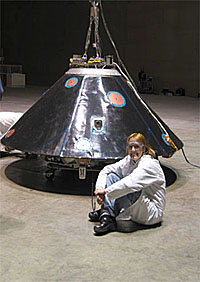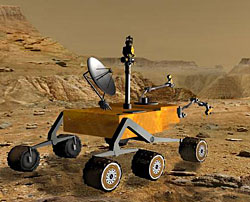Feature
Woman and Machine
09.01.05
| Who are NASA's Space Science Explorers? The scientist studying black holes in distant galaxies. And the engineer designing robotic instruments for probing hard-to-reach planets. But also the teacher explaining the mysteries of the cosmos. And the elementary schooler wondering if life exists anywhere besides Earth. All of these people are Space Science Explorers -- they are all connected by their quest to explore and understand our solar system and universe. This monthly series will introduce you to NASA Space Science Explorers, young and old, with a variety of backgrounds and interests. Nominate a Space Science Explorer! Tell us about the Space Science Explorers you know. We're looking for students, teachers, scientists and others who have a connection to NASA, whether they work for the agency or are involved in a NASA-supported mission or program. Send your nominations to Dan Stillman: dan_stillman@strategies.org. |

|
Image to right: Jaime Dyk takes a break in front the Mars rovers' backshell, designed to protect the rovers during their seven-month trip to Mars. Credit: NASA
One of those engineers, Jaime Dyk, came to NASA's Jet Propulsion Laboratory just as the work began in early 2001. Later that year, she was faced with an unusual choice when she tried out for the Laker Girls, one of the world's most prestigious cheerleading squads. She made it to final cuts, only to realize there wasn't enough time in her life for both NASA and cheerleading. Jaime recently talked with Space Science Explorers about why she chose science over cheerleading, how she felt when the rovers landed on Mars and whether being an engineer is different than she thought it would be.
Space Science Explorers: How did you first get interested in space and Mars?
Jaime: I got interested in working on Mars projects at an early age. It was my seventh-grade science teacher that taught us a lot about space, Mars and NASA. I caught the Mars bug at that time and decided that I wanted to build "stuff" to go to Mars. Before that, I was convinced that I wanted to be a marine biologist and work with dolphins at Sea World.
SSE: How did you decide between the Laker Girls and space science?
Jaime: Trying out for the Laker Girls was one of those things that I thought would be interesting -- one of those stories that you could tell people, "I did that once." During tryouts, I realized the time commitment that would be expected and that it wouldn't really work for me and my goals at JPL. So, I dropped out. My focus has always been to be the best engineer I can be.
SSE: How did you help prepare the Mars rovers for their mission?
Jaime: I was working primarily on the Entry, Descent and Landing team. We put the hardware together and test how it works as a system. This is usually the first time the hardware is tested like it would function on Mars. I also got to run tests on the rocket, airbag and structural systems. It was a great way to learn a lot about different mechanical systems.
SSE: How did you feel when the Mars rovers landed successfully and started beaming pictures back to Earth?
Jaime: It was bittersweet -- I know, not the answer you expect. It's amazing to see all of your hard work pay off. But it is sad, too. When you work on a project of this magnitude, the people you work with become your family. You spend long days, weekends and holidays with everyone. Now that it was over, everyone was moving on to other projects. That was sad. It's also sad to realize that you'll never see the rovers again.

|
Jaime: Now I'm working on the Mars Science Laboratory. This is a large rover scheduled to go to Mars in 2009. I am working with a team of engineers that is designing all of the hardware that makes the rover move. This includes the wheels, suspension system and a "rocker," which keeps the rover balanced. It is a dream job for me and I am very excited about it.
Image to left: The Mars Science Laboratory has more tools than the rovers. It will study Mars in greater detail, too. Credit: NASA
SSE: How does being an engineer compare with what you thought it would be?
Jaime: I couldn't have imagined how cool it would be. There is nothing like sitting in the control room when the first images come back from Mars and you see your hardware sitting in the Martian dirt. My images of being an engineer before coming to JPL were from the movies -- a lot of men in short-sleeved white shirts with skinny black ties, very formal and uptight. That couldn't be farther from the environment I get to work in.
SSE: Looking back, what subjects in school were the most important for the work you do today?
Jaime: I think the classes I use most are my math and physics classes. I also think it's important in my field to be able to communicate. We spend a lot of time coming up with ideas, but it is being able to present those ideas to other people that makes your ideas eventually fly.
SSE: What advice would you give to kids who are interested in science but are worried that it will be too hard for them?
Jaime: I would say that if you want something bad enough, then don't let anything get in your way. The work I do is hard, but I am only one person in a team of individuals. It is the group of people that work together to deliver a product. No one person could ever do what we do. It is the combined efforts of a lot of engineers, scientists and others that aid in the success of everything we do.
See previous Space Science Explorers articles:
+ View site
Related Resources:
NASA's Mars Exploration Program
+ View site
Jason Expedition: Mysteries of Earth and Mars
+ View site